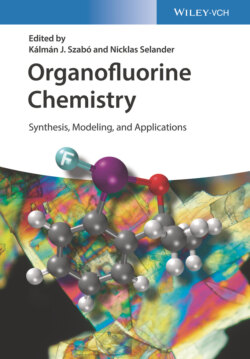Читать книгу Organofluorine Chemistry - Группа авторов - Страница 34
2.3.1 Reactions Using Perfluorocarboxylic Anhydride/Urea·H2O2
ОглавлениеBräse and coworkers reported a radical perfluoroalkylation of aromatic compounds by using a combination of perfluorocarboxylic anhydrides and urea‐hydrogen peroxide; a mixture of 10 equiv of urea‐hydrogen peroxide (urea·H2O2) and 20 equiv of the carboxylic anhydrides generated diacyl peroxide in situ, and this reacted with arene substrates (Scheme 2.33) [65]. In that work, 15 perfluoroalkylated compounds were synthesized in up to 50% yield.
Scheme 2.33 Aromatic perfluoroalkylation using perfluorocarboxylic anhydride/urea·H2O2.
The group of Sodeoka and Kawamura independently developed perfluoroalkylations using diacyl peroxide generated in situ from anhydrides/urea·H2O2, and described various transformations, in particular bifunctionalization‐type perfluoroalkylations of alkenes (Schemes Scheme 2.34 and Scheme 2.35) [66, 67]. Although the reactive perfluoroalkyl radical could be generated via thermal fragmentation of the diacyl peroxide, heating of a mixture of alkene and in situ‐generated diacyl peroxide gave a complex mixture. They hypothesized that reactivity control of the alkyl radical formed by the reaction of alkene with perfluoroalkyl radical would be the key to a successful reaction [68a–c]. First, catalytic control using copper catalyst was demonstrated; when a catalytic amount of [Cu(CH3CN)4]PF6] was added to a mixture of substrate and the peroxide, not only the selectivity but also the conversion was dramatically improved, affording allylic perfluoroalkylation products in up to 95% yield (Scheme 2.34a) [68a].
Scheme 2.34 Cu‐catalyzed perfluoroalkylations of alkenes. DBU, 1,8‐diazabicyclo[5.4.0]undec‐7ene; AIBN, 2,2′‐azobis(isobutyronitrile).
Scheme 2.35 Metal‐free alkene perfluoroalkylations: (a) carbo‐perfluoroalkylation of aromatic alkenes; (b) bifunctionalization‐type perfluoroalkylations of styrenes.
In addition, alkenes bearing a pendant sulfonamide group efficiently gave a wide variety of intramolecular amino‐perfluoroalkylation products: perfluoroalkyl group‐containing aziridines and pyrrolidines [68b]. In particular, the aziridine product proved to be a good building block; it was derivatized to various amines, including indole alkaloid analogs. Furthermore, their group developed allylic and amino‐chlorodifluoromethylations of alkenes, in which the use of Cu(O2CCF3)2 as the catalyst with pyridine additive was found to improve the yield (Scheme 2.34b) [68c]. The chlorodifluoromethyl group of the products was transformed into difluorodiene, difluoromethyl‐, or trimethylsilyldifluoromethyl groups in order to confirm the utility of these products as synthetic building blocks.
They also performed metal‐free perfluoroalkylations by using perfluorocarboxylic anhydride/urea·H2O2, focusing on the structure of the substrates (Scheme 2.35). When an alkene bearing an aromatic ring at an appropriate position of the carbon side chain was reacted with in situ‐generated diacyl peroxide, intramolecular carbo‐perfluoroalkylation via radical cyclization occurred (Scheme 2.35a) [68a–c].
This method provides simple access to benzo‐fused carbo‐ and heterocyclic products in excellent yields. Notably, switching from amino‐ to carbo‐perfluoroalkylation of the same substrate, e.g. N‐tosyl allylamine, by the removal of copper catalyst remarkably increased the diversity of available perfluoroalkylated molecules. Furthermore, styrene derivatives were found to undergo bifunctionalization‐type perfluoroalkylation, oxy‐ and amino‐perfluoroalkylations, via a carbocation, which is a rare intermediate under metal‐free conditions (Scheme 2.35b) [68d]. Mechanistic studies suggested that the unique redox properties of the peroxide reagent, styrene, and the radical cation formed accounted for the extraordinary carbocation formation under metal‐free conditions.
